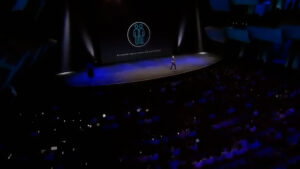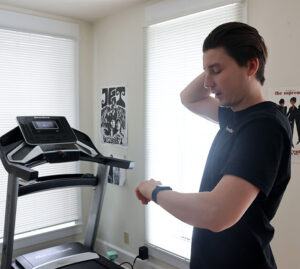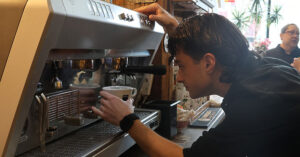Diving Deep into IU Ballerinas
By Will Morris, Ellie Belshaw, Jola Wright and Sylvia Sasse
BLOOMINGTON, Ind (April 3, 2025)
As a young girl, Anjuli Paul can still recall the times she spent twirling around her living room. She smiles as she remembers, “I was always just dancing around the house.” Her passionate path as a ballerina began with those carefree moments of spontaneous movement that eventually evolved into a serious endeavor.
Paul, now a freshman at Indiana University, began her formal ballet training at the age of four, encourag
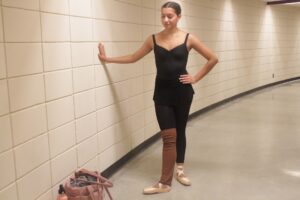
ed by her mother, who thought it would be a good fit. But it wasn’t until she was eleven years old that ballet started to mean more to Paul. “That’s when I really started to take it seriously,” she recalls. Ballet changed over time from being a mere pastime to become her life’s passion.
“I think my favorite part of dancing has always been performing,” adds Paul. “It’s just such a special experience.” Paul sees ballet as an opportunity to share something really personal, rather than just a form of dance. She notes that her main form of self-expression has always been dance. Paul, who describes herself as an introvert, struggles to express her feelings in words, but she is able to do it on stage with each leap and pirouette.
Her capacity for nonverbal communication is the foundation of Paul’s relationship with dance. “Dance has always been a way for me to express myself,” she adds thoughtfully. Deeming herself a

s an introvert, expressing herself through movement
has always felt natural to her.
A significant part of being a ballerina at Indiana University is not just the performances, but the preparation that goes into each one. Paul takes us behind the scenes to see what it’s like to get ready for a show, starting by explaining their pre-performance ritual. “We stand in a circle with the group, close our eyes, and squeeze each other’s hands. It’s a way for us to center ourselves and prepare for what’s coming,” she shares.
The process leading up to a performance starts long before the first rehearsal. A choreographer arrives with a preliminary casting list, called ‘learning groups,’ to begin developing the routine. The following rehearsals serve as an audition, a time when the dancers may learn a “key phrase” of choreography. This could determine their role in the final performance. “After the choreographers leave, they won’t come back until tech week, which is the week before the show,” Paul explains. “Once we have the choreography, we’re running it every day, every week.”
Each day up until the performance is filled with rigorous rehearsals. The stakes are high, especially during tech week, which Paul describes as the “craziest” part of the process. “We are here from 11 a.m. to 10 p.m. every day,” Paul says, laughing. “I tell my friends I’m going into survival mode.”
During tech week, the dancers run the entire show in full makeup and costumes, and practice with the orchestra. Though a dem
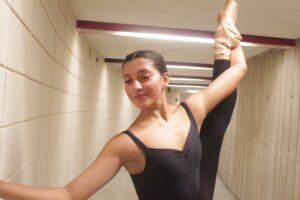
anding schedule, it ensures the dancers are prepared for every moment of the show. Once tech
week is over, the group performs all week long, with the Monday following the performance being the only break. “The whole process is very intense,” Paul states.
The entire process—from auditioning dancers to selecting choreography and rehearsing for performances—takes about eight weeks. Paul’s most recent piece, ‘Sandpaper Ballet’, started at the very beginning of the semester. “From there we’ve just been working on it through now,” she says. “I would say it usually takes about two months.”
Paul’s path to Indiana University was shaped by years of dedication.She became even more dedicated to dance when she transferred to a Boston boarding school for her senior year of high school. She attributes this transition to the nature of being a dancer, having previously been living away from home since she was fourteen. “It definitely made the transition to college easier, especially with living away from home,” Paul added.
Her time in Boston prepared her for the professional demands of ballet, especially the expectations at Indiana University. “Being able to work with the Boston Ballet Company really helped prepare me for that more professional environment,” she says. “It also helped with that transition from being a student to being more of a professional dancer.”
As she embarks on her freshman year, Paul continues to push herself both as a dancer and an individual. She believes ballet brings out the best version of herself. “It really allows me to express myself,” she explains. “There are certain things you can’t explain with words, and for me the way to express that is through movement.”
Her experience is proof of the ability of performance to not only display skill but also to discover one’s voice in a manner that words cannot always express. Ballet is more than just an art form to Anjuli Paul; it’s a place where she discovers who she is and shares that with the world.
From the living room to the stage, her journey is just beginning, but it’s clear that dance will continue to be a key part of her story, both at Indiana University and beyond.
https://youtu.be/rDuIrTfzyaA



